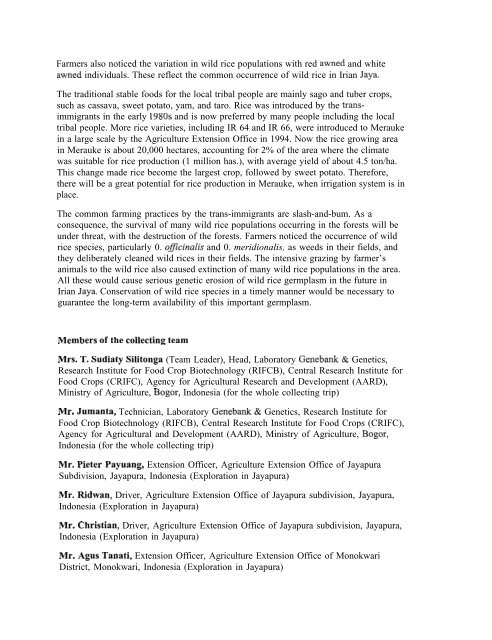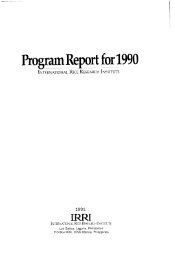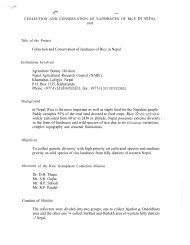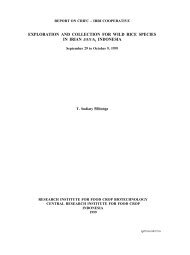Appendix 1 - IRRI
Appendix 1 - IRRI
Appendix 1 - IRRI
Create successful ePaper yourself
Turn your PDF publications into a flip-book with our unique Google optimized e-Paper software.
Farmers also noticed the variation in wild rice populations with red awned and white<br />
awned individuals. These reflect the common occurrence of wild rice in Irian Jaya.<br />
The traditional stable foods for the local tribal people are mainly sago and tuber crops,<br />
such as cassava, sweet potato, yam, and taro. Rice was introduced by the transimmigrants<br />
in the early 1980s and is now preferred by many people including the local<br />
tribal people. More rice varieties, including IR 64 and IR 66, were introduced to Merauke<br />
in a large scale by the Agriculture Extension Office in 1994. Now the rice growing area<br />
in Merauke is about 20,000 hectares, accounting for 2% of the area where the climate<br />
was suitable for rice production (1 million has.), with average yield of about 4.5 ton/ha.<br />
This change made rice become the largest crop, followed by sweet potato. Therefore,<br />
there will be a great potential for rice production in Merauke, when irrigation system is in<br />
place.<br />
The common farming practices by the trans-immigrants are slash-and-bum. As a<br />
consequence, the survival of many wild rice populations occurring in the forests will be<br />
under threat, with the destruction of the forests. Farmers noticed the occurrence of wild<br />
rice species, particularly 0. officinalis and 0. meridionalis, as weeds in their fields, and<br />
they deliberately cleaned wild rices in their fields. The intensive grazing by farmer’s<br />
animals to the wild rice also caused extinction of many wild rice populations in the area.<br />
All these would cause serious genetic erosion of wild rice germplasm in the future in<br />
Irian Jaya. Conservation of wild rice species in a timely manner would be necessary to<br />
guarantee the long-term availability of this important germplasm.<br />
Members of the collecting team<br />
Mrs. T. Sudiaty Silitonga (Team Leader), Head, Laboratory Genebank & Genetics,<br />
Research Institute for Food Crop Biotechnology (RIFCB), Central Research Institute for<br />
Food Crops (CRIFC), Agency for Agricultural Research and Development (AARD),<br />
Ministry of Agriculture, Bogor, Indonesia (for the whole collecting trip)<br />
Mr. Jumanta, Technician, Laboratory Genebank & Genetics, Research Institute for<br />
Food Crop Biotechnology (RIFCB), Central Research Institute for Food Crops (CRIFC),<br />
Agency for Agricultural and Development (AARD), Ministry of Agriculture, Bogor,<br />
Indonesia (for the whole collecting trip)<br />
Mr. Pieter Payuang, Extension Officer, Agriculture Extension Office of Jayapura<br />
Subdivision, Jayapura, Indonesia (Exploration in Jayapura)<br />
Mr. Ridwan, Driver, Agriculture Extension Office of Jayapura subdivision, Jayapura,<br />
Indonesia (Exploration in Jayapura)<br />
Mr. Christian, Driver, Agriculture Extension Office of Jayapura subdivision, Jayapura,<br />
Indonesia (Exploration in Jayapura)<br />
Mr. Agus Tanati, Extension Officer, Agriculture Extension Office of Monokwari<br />
District, Monokwari, Indonesia (Exploration in Jayapura)





